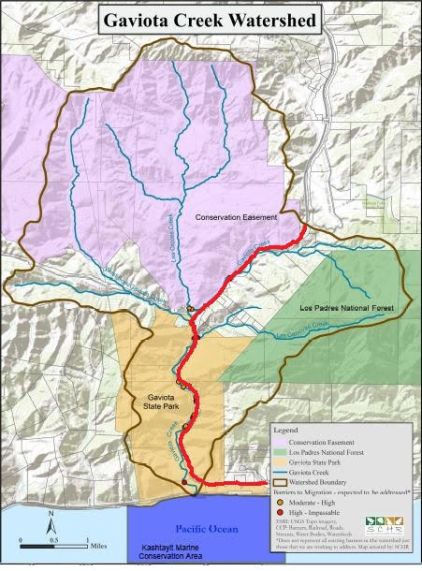Controversy Erupts over Use of Spring Water by Gaviota Beach
Conservationists Seek to Force State Parks to Adhere to Agreements

When it rains in Santa Barbara County, the beaches might get about 10 or 15 inches over the course of a year, but at Gaviota Peak, it can be more like 60 inches. That’s been important for the life cycle of the steelhead trout that swim through the estuary alongside the campgrounds and parking lot at Gaviota State Beach to reach the upper stretches of Gaviota Creek, which wraps around the backside of Gaviota Peak. Keeping the estuary open and stocked with creek water is the intent of a lawsuit newly filed by the Coastal Ranches Conservancy against state Parks & Rec.

All that rainwater falling at the peak percolates into the sandstone, feeding Nojoqui Creek and the waterfall, but most of it ultimately flows to Gaviota Creek, including the waters from Las Cruces Spring, said Doug Campbell, executive director of the conservancy. State Parks taps the spring for the rest stops on Highway 101 and also for the beach park, but Campbell’s group recently received documents through a public records request that they believe shows that Parks takes more water from the spring than it should.
Las Cruces Spring is above the Gaviota Hot Springs, not far from where State Route 1 and the 101 diverge. In 1998, when State Parks was allowed to divert water from the spring and treat it to potable standards, the National Marine Fisheries and other groups were concerned about the potential impact on the Southern California steelhead, which was listed as endangered in 1997. The conservancy argues that the permit documents show that when the water flow slowed to less than 30 gallons per minute between July and September, State Parks was supposed to use well water or stored water instead.
“With the drought, it’s down to 17 gallons a minute,” Campbell said, “and the park has never held up its end of the bargain.”
Gaviota Estuary receives what is now a low flow of creek water, but it too suffers directly from a permit caveat that the conservancy claims State Parks has ignored. When the estuary was filled in to enlarge the park’s campground and parking lot, State Parks agreed at the time to restore four acres of the estuary, according to the documents. That never happened either, Campbell said.
The estuary is open to the ocean and fills with the tidal flow as well as the water from Gaviota Creek. It supports myriad plant and animal species, including the endangered steelhead trout and the threatened red-legged frog. Asked for comment about the allegations, State Parks senior counsel Kathryn Tobias said zir office did not comment on pending litigation.
Campbell’s organization had another reason to resort to a lawsuit. Caltrans is working toward removing the fish passage barriers on Gaviota Creek, which is a $20 million undertaking. “We want to make sure that is really going to work,” he said, “and for that, we need to have a healthy estuary.”
Support the Santa Barbara Independent through a long-term or a single contribution.




You must be logged in to post a comment.